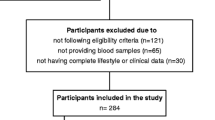Abstract
Adiponectin has been recognized as a potent regulator of metabolism possessing anti-inflammatory and anti-atherogenic functions and inversely associated with increasing incidents of type 2 diabetes and obesity. In this study, we investigated the changes in adiponectin level of 193 Arab and 132 Asian women were compared. Overall, Arab women had statistically significant higher levels of adiponectin 17.84 (1.047) μg/mL than Asians 12.87 (1.049) μg/mL. In conclusion, our data demonstrates that Arab women poses high adiponectin level compared to Asians and the protective role of adiponectin in Arab women against metabolic disorders requires further attention.
Similar content being viewed by others
To the Editor
Adiponectin has been recognized as a potent regulator of metabolism possessing anti-inflammatory and anti-atherogenic functions. Its level in human plasma is inversely associated with increasing incidents of type 2 diabetes, cardiovascular disease risk and obesity [1]. Significantly different levels of adiponectin have been reported in different ethnicities. For example, Asians have a lower adiponectin plasma level than Caucasians, which is consistent with the increased risk of metabolic disorders among Asians [1].
In this study, plasma level of adiponectin of 193 Arab and 132 Asian women living in Kuwait was assessed using the multiplexing immunobead array platform (Luminex, Austin, TX) using a 2-Plex kit (BioRad, Hercules, CA). All subjects gave their written consent to participate in the study. Full description of the study design was published by Elkum et al. [2]. Briefly, our samples were collected from the six governorates of the state of Kuwait, where random samples were collected from each stratum with proportional allocations. Adiponectin level are reported as geometric means and their standard errors according to BMI. BMI between 18.5 and 24.9 was considered lean, 25 to 29.9, overweight, ≥30 was considered obese). Clinical characteristics of the population are shown in Table 1.
Overall, Arab women had statistically significant higher levels of adiponectin 17.84 (1.047) μg/mL than Asians 12.87 (1.049) μg/mL. Comparing across different levels of BMI, Arab lean women had the highest adiponectin level at 23.73 (1.15) μg/mL; overweight women, 17.10 (1.08) μg/mL; and obese, 14.30 (1.06) μg/mL. On the other hand, adiponectin level in lean Asians was 17.00 (1.09) μg/mL, overweight 11.07 (1.07) μg/mL, while obese women had 11.42 (1.10) μg/mL Figure 1.
The significance of this study is that it compared cohorts of Arab and Asian women residing in Kuwait. The adiponectin levels for Asians reported in this study match with those reported in other studies using Asian samples such as Mente et al. (Adiponectin 11.02 ± 0.76 μg/mL, BMI 26.1 ± 0.3 Kg/m2) [1] and Smith et al. (Adiponectin 10.73 ± 1.35 μg/mL, BMI 28.7 ± 0.86 Kg/m2) [3]. Our data shows that Arab women have a significantly higher adiponectin level than Asians. Arab women might also have higher levels of adiponectin compared to women from other ethnicities such as Hispanic (11.7 μg/mL), Caucasians (15.6 μg/mL), far-East Filipinos (8.9 μg/mL) and African Americans (9.67 μg/mL) [4].
Caucasians have the highest reported adiponectin levels out off all ethnicities. Using an Asian population as a bench mark, adiponectin levels in lean Arab women might be higher than those in Caucasians. Araneta et al. reported that lean Caucasian women had a mean adiponectin level of 15.66 μg/mL, which is significantly lower than the 23.73 μg/mL concentrations reported in the current study [4].
In conclusion, our data shows that lean Arab women have a high adiponectin levels compared to Asians and potentially other ethnicities especially Caucasians. In the future, large cohort studies involving other ethnicities, mainly Caucasians, alongside Arabs will be beneficial to further demonstrate the role of adiponectin in this population.
References
Mente A, Razak F, Blankenberg S, Vuksan V, Davis AD, Miller R, et al. Ethnic variation in adiponectin and leptin levels and their association with adiposity and insulin resistance. Diabetes Care. 2010;33:1629–34. doi:dc09-1392.
Elkum N, Al-Arouj M, Sharifi M, Behbehani K, Bennakhi A. Cardiovascular disease risk factors in the South Asian population living in Kuwait: a cross-sectional study. Diabet Med. 2014;31(5):531–9. doi:10.1111/dme.12386.
Smith J, Al-Amri M, Sniderman A, Cianflone K. Leptin and adiponectin in relation to body fat percentage, waist to hip ratio and the apoB/apoA1 ratio in Asian Indian and Caucasian men and women. Nutr Metab (Lond). 2006;3:18. doi:1743-7075-3-18.
Araneta MR, Barrett-Connor E. Adiponectin and ghrelin levels and body size in normoglycemic Filipino, African-American, and white women. Obesity (Silver Spring). 2007;15(10):2454–62. doi:15/10/2454.
Acknowledgment
We would like to thank our study team for their efforts and excellent work. We are grateful to the Biochemistry and Molecular Biology Unit members, Clinical Laboratory and the Tissue Bank Core Facility at DDI for their contribution in performing the biochemical profile analysis and handling samples, respectively. We are also indebted to Kuwait Foundation for the Advancement of Sciences (KFAS) for financial support of this research project (RA-2010-004).
Author information
Authors and Affiliations
Corresponding author
Additional information
Competing interests
The authors declare that they have no competing interests.
Authors’ contributions
MA: data interpretation and wrote the manuscript. KB: Critically revised the manuscript. NE: principal investigator handled data management, data analysis and interpretation, and wrote the manuscript. Dr. Elkum, the study principal investigator, is the guarantor of this work and, as such, had full access to all the data in the study and takes responsibility for the integrity of the data and the accuracy of the data analysis. All authors read and approved the final manuscript.
Rights and permissions
This article is published under an open access license. Please check the 'Copyright Information' section either on this page or in the PDF for details of this license and what re-use is permitted. If your intended use exceeds what is permitted by the license or if you are unable to locate the licence and re-use information, please contact the Rights and Permissions team.
About this article
Cite this article
Abu-Farha, M., Behbehani, K. & Elkum, N. High adiponectin levels in lean Arab women compared to Asian women. Biomark Res 3, 7 (2015). https://doi.org/10.1186/s40364-015-0032-5
Received:
Accepted:
Published:
DOI: https://doi.org/10.1186/s40364-015-0032-5




